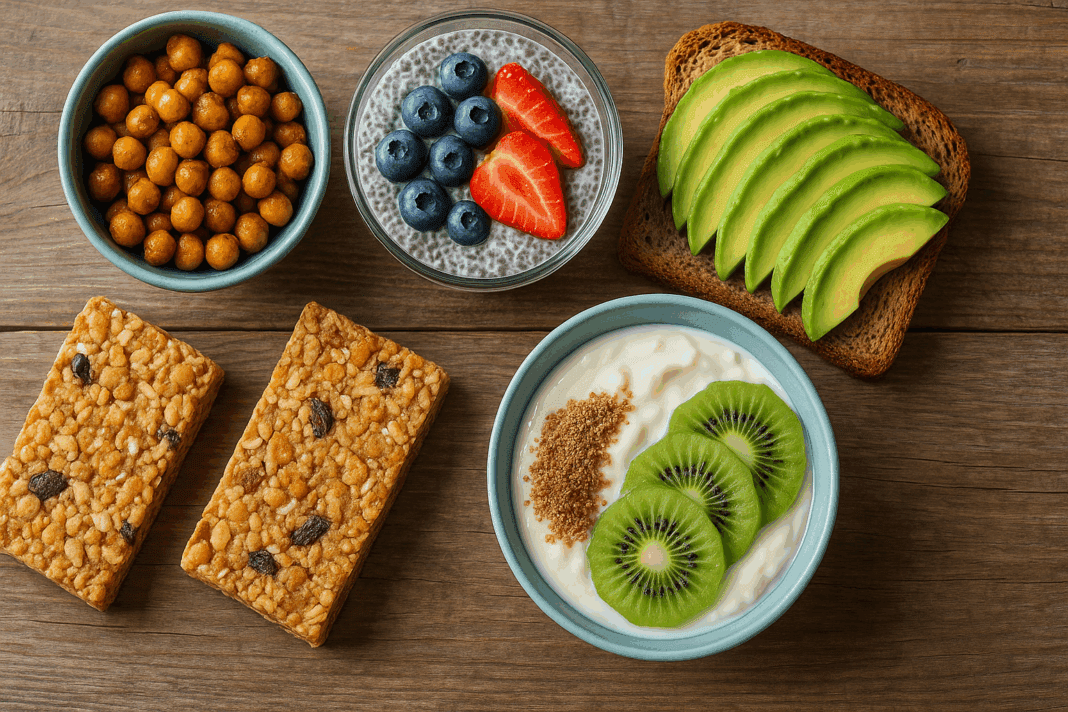Introduction: Understanding the Power of High Fiber Snacks for Digestive Wellness
In today’s health-conscious world, more people are beginning to recognize the importance of gut health and the foundational role that fiber plays in supporting it. High fiber snacks, in particular, offer a convenient and flavorful way to integrate gut-friendly nutrients into our daily routines. These snacks not only enhance digestive efficiency but also work in harmony with probiotics to cultivate a balanced and thriving gut microbiome. Whether it’s through fruits with low sugar and high fiber, good high fiber snacks like roasted chickpeas, or healthy fiber snacks such as homemade oat bars, these functional foods go beyond mere satiety. They actively contribute to long-term wellness by encouraging regularity, reducing inflammation, and improving nutrient absorption. As we delve into this comprehensive guide, we will explore how to select and enjoy ingredients with fiber and good flavor, create meals with fiber that don’t compromise on taste, and discover fiber rich recipes that make your snack time not only healthy but genuinely enjoyable.
You may also like: The Ultimate Guide to Gut Healthy Meals: Best Meals for Gut Health and Nourishing Recipes You’ll Love
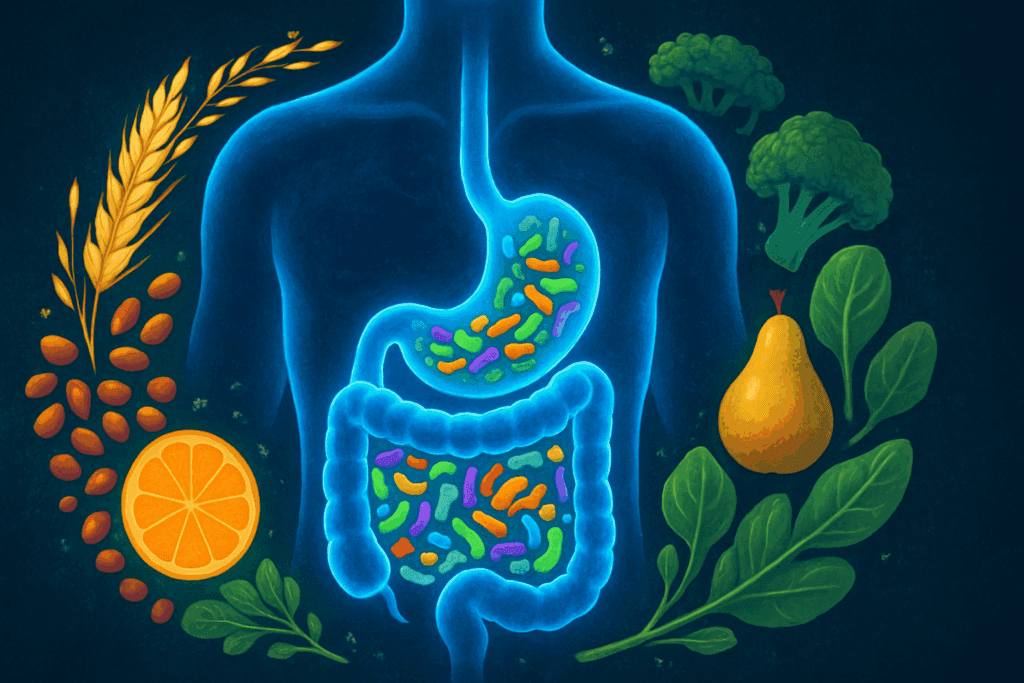
Why Gut Health and Probiotics Matter More Than Ever
Gut health is a cornerstone of overall wellness, influencing everything from immunity and metabolism to mood and brain function. Central to this complex system is the gut microbiota—a diverse community of microorganisms that rely heavily on dietary fiber for sustenance. Fiber acts as a prebiotic, fueling the growth of beneficial bacteria and enhancing the effectiveness of probiotic strains. Without adequate fiber, even the most potent probiotic supplements may underperform. Therefore, maintaining a diet rich in fiber through snacks and meals is vital for supporting this intricate symbiosis. The interplay between high fiber intake and probiotics leads to improved digestion, reduced risk of chronic illness, and enhanced immune resilience. Incorporating high fiber dinner foods and snacks throughout the day provides consistent nourishment to the gut, creating a stable environment for these microorganisms to flourish. This becomes especially important in modern lifestyles where processed foods and stressors can easily disrupt the natural balance of our digestive systems.
Exploring Ingredients with Fiber and Good Flavor
One of the most appealing aspects of high fiber snacks is that they do not have to be bland or boring. In fact, many ingredients with fiber and good flavor are already staples in the average kitchen. Take for example, avocados, which provide a creamy texture along with heart-healthy monounsaturated fats and an impressive dose of fiber. Similarly, berries like raspberries and blackberries not only burst with vibrant flavors but also offer a significant amount of dietary fiber per serving. Legumes, including lentils, chickpeas, and black beans, can be transformed into snackable spreads, dips, or even roasted treats. Whole grains such as oats, quinoa, and brown rice form the base of many fiber rich recipes, delivering both complex carbohydrates and prebiotic fibers. Nuts and seeds, from almonds to chia, offer crunch, satiety, and gut-nourishing benefits when added to yogurt, salads, or snack bars. The key lies in creative pairing—combining these ingredients to maintain flavor without sacrificing fiber content. With mindful preparation, each bite can be a harmonious blend of taste and nutrition.
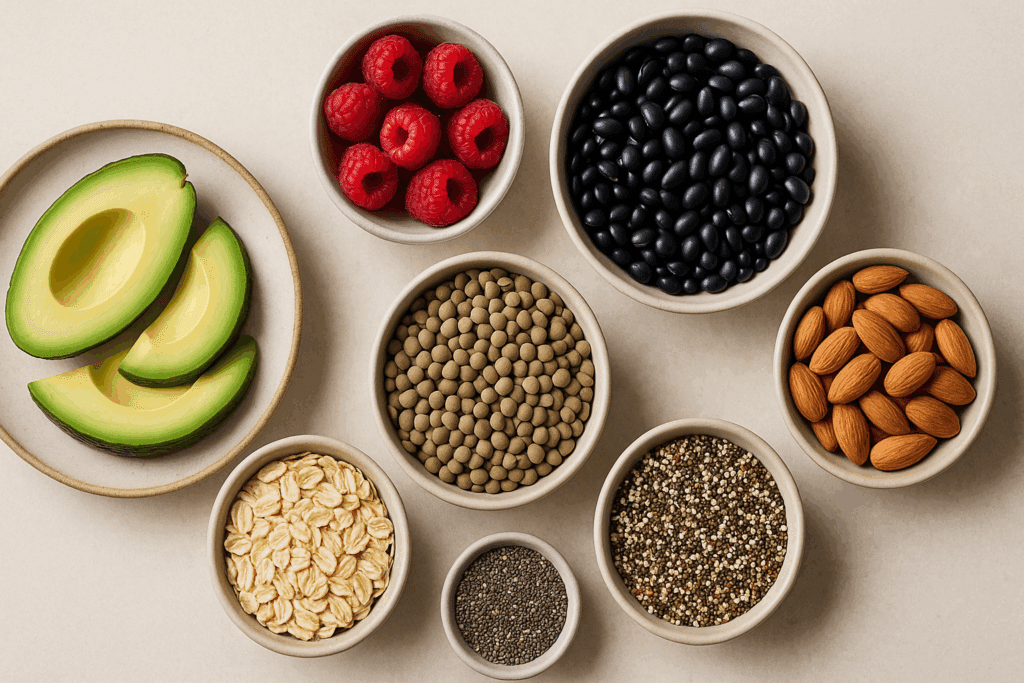
Do Dairy-Based Snacks Like Yogurt Contain Fiber?
A common question among health enthusiasts is, “Does yogurt have fiber?” While traditional dairy yogurt is not a natural source of dietary fiber, it still plays a critical role in gut health due to its probiotic content. However, with the growing interest in gut-friendly foods, many brands now offer yogurts fortified with fiber, either through added fruit purees, inulin, or grain-based inclusions like oats. Plant-based yogurts, often made from almond, coconut, or oat milk, frequently come enriched with natural fibers and tend to offer a more complete digestive package. Pairing yogurt with fiber-rich toppings such as flaxseed, granola, or fruits with low sugar and high fiber (like kiwi or pear) creates a synergistic snack that supports both probiotic and prebiotic needs. In essence, while yogurt alone may not fulfill your fiber requirements, it serves as an excellent base for building healthy fiber snacks that contribute to gut resilience and microbial diversity.
Crafting High Fiber Snacks That Are Both Delicious and Nutritious
Creating high fiber snacks that delight the palate while supporting digestive health involves balancing flavor, texture, and nutritional density. Homemade energy bites made with oats, dates, and chia seeds offer natural sweetness and a potent dose of fiber. Similarly, whole grain toast topped with mashed avocado and hemp seeds can provide a savory alternative to sugary snacks, while delivering high levels of dietary fiber and essential fatty acids. Trail mixes composed of dried fruits with low sugar and high fiber—such as dried figs or apricots—combined with raw nuts and coconut flakes present a satisfying, on-the-go option. Even simple roasted vegetables, like spiced carrots or Brussels sprouts, can be transformed into fiber rich meals when paired with protein and whole grains. The focus should be on variety and simplicity. By choosing a rotation of nutrient-dense, fiber-loaded ingredients and assembling them in creative ways, snack time can be a rewarding and health-supportive habit.
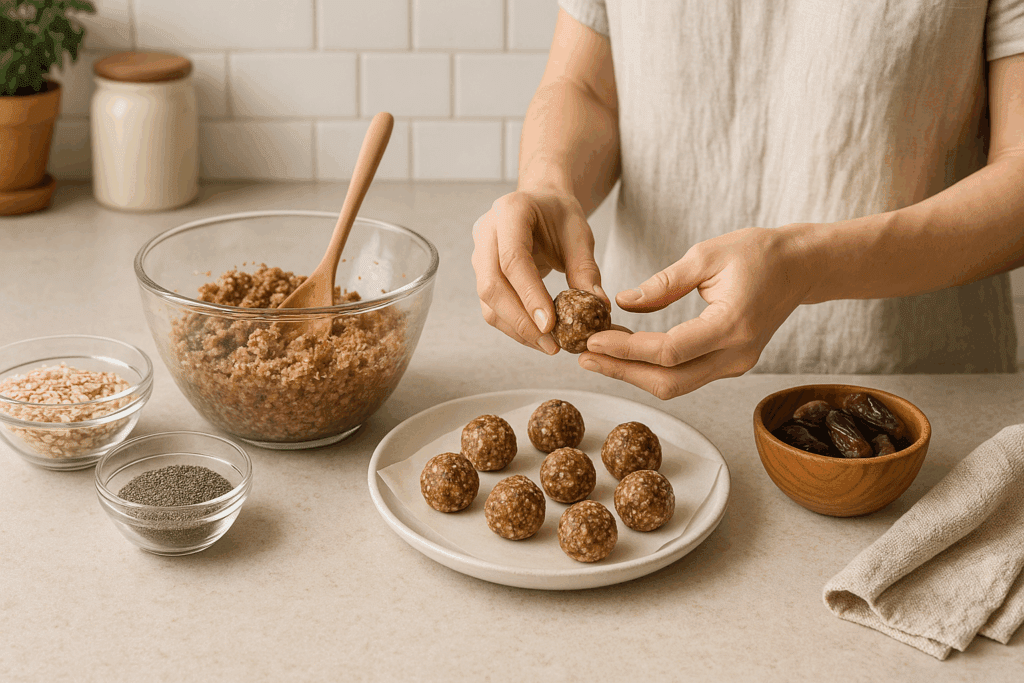
The Best Healthy Fiber Snacks for a Balanced Gut
When selecting snacks that foster gut balance, it’s important to consider not only fiber content but also the presence of complementary nutrients such as polyphenols, antioxidants, and healthy fats. Healthy fiber snacks like hummus paired with sliced bell peppers or carrots offer both soluble fiber and hydration. A small bowl of air-popped popcorn with a drizzle of olive oil and a sprinkle of nutritional yeast can be a low-calorie, high-satiety snack. For those with a sweet tooth, a chia pudding made with almond milk, berries, and a touch of cinnamon can fulfill cravings while delivering impressive fiber and antioxidant content. Another exceptional choice is psyllium husk-based crackers, which can be homemade or store-bought, and provide a potent form of soluble fiber known to aid regularity and gut motility. Integrating these good high fiber snacks into your daily routine can lead to noticeable improvements in digestive function, energy levels, and overall vitality.
How High Fiber Snacks Complement Meals with Fiber
High fiber snacks do more than just bridge the gap between meals; they play a pivotal role in ensuring that your total daily fiber intake meets recommended guidelines. When spaced appropriately throughout the day, snacks serve as fiber fortification, enhancing the benefits of meals with fiber such as grain bowls, hearty salads, and vegetable-rich stir-fries. For example, enjoying a handful of almonds mid-morning can help stabilize blood sugar before a lunch consisting of lentil soup and a quinoa salad. In the evening, a light snack of Greek yogurt topped with chia seeds and sliced apple can amplify the impact of high fiber dinner foods like roasted sweet potatoes and sautéed kale. This strategic layering of fiber-rich choices throughout the day ensures a more consistent fermentation process in the gut, maximizing the production of short-chain fatty acids (SCFAs) that support colon health, reduce inflammation, and regulate immune function. As a result, each snack becomes an integral component of a fiber-rich dietary approach.

Delicious and Functional: Dinner with High Fiber for Evening Digestive Support
Dinnertime presents an excellent opportunity to include dinner with high fiber that not only satisfies hunger but also supports overnight digestive health. Unlike quick daytime snacks, dinner can incorporate a broader range of ingredients and culinary techniques to elevate both flavor and fiber content. Consider a hearty stew made with lentils, root vegetables, and barley—each component adding layers of fiber and phytonutrients. Alternatively, a roasted vegetable platter featuring eggplant, Brussels sprouts, and beets served over wild rice can provide an aesthetically pleasing and digestion-friendly evening meal. Incorporating legumes into casseroles or pasta dishes boosts both fiber and protein, making these options ideal for sustained satiety and blood sugar balance. Pairing these meals with a side salad of arugula, avocado, and seeds further enhances the prebiotic potential. Such thoughtful compositions ensure that your evening intake contributes to microbial nourishment and gut lining repair during sleep, which is when the gut microbiome engages in restorative functions.
Mastering the Art of Fiber Rich Recipes That Don’t Sacrifice Taste
One of the common misconceptions about fiber-rich recipes is that they are inherently bland or unappealing. In reality, with a bit of culinary ingenuity, meals that are high in fiber can rival any gourmet dish in taste and presentation. Using aromatic spices like cumin, turmeric, and smoked paprika not only enhances flavor but also adds anti-inflammatory benefits. Swapping refined grains for whole grains in recipes—such as using brown rice for risotto or whole wheat flour for pancakes—retains the comforting texture while significantly increasing fiber intake. Incorporating vegetables into unexpected places, such as shredded zucchini in muffins or cauliflower in pizza crust, introduces fiber in a stealthy yet delicious way. Desserts, too, can be transformed into fiber-rich treats by using ingredients like black beans in brownies or flaxseed in cookies. By shifting the culinary paradigm to prioritize fiber without compromising flavor, you create meals that nourish both the body and the senses.
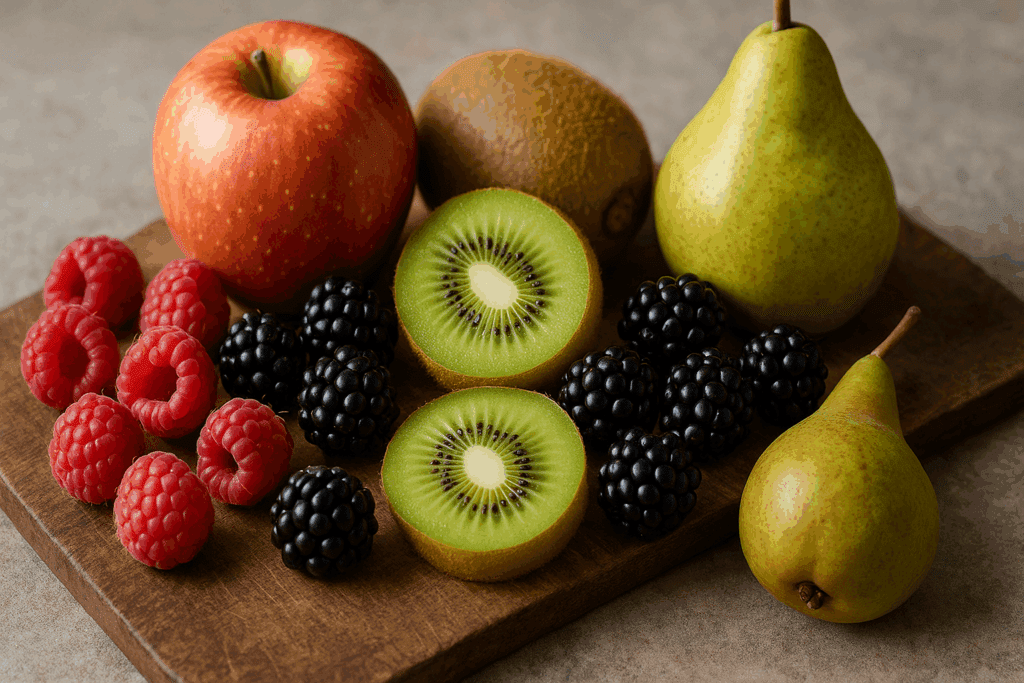
Fruits with Low Sugar and High Fiber: A Gut-Friendly Sweet Treat
Fruits often receive mixed reviews in the context of gut health due to their natural sugar content. However, many fruits with low sugar and high fiber offer the best of both worlds: a sweet flavor profile and digestive benefits. Berries like strawberries, raspberries, and blackberries are exemplary choices, containing high levels of fiber while maintaining a relatively low glycemic load. Apples, especially with the skin intact, provide pectin, a type of soluble fiber known for its prebiotic effects. Kiwifruit is another standout, with enzymes that aid in digestion and a favorable fiber-to-sugar ratio. Pears and plums, when eaten in moderation, can contribute to daily fiber goals without excessive sugar spikes. These fruits not only make excellent standalone snacks but also elevate the nutritional profile of other dishes when used as toppings or mix-ins. Embracing these options as part of your snack repertoire ensures variety, sweetness, and gut health support in every bite.

Building a Daily Routine Around Good High Fiber Snacks
Establishing a consistent routine that includes good high fiber snacks can transform digestive health from a passive concern into an active practice. Start your day with a breakfast that incorporates fiber from the outset—perhaps overnight oats with chia seeds and sliced banana. Mid-morning, opt for a few squares of dark chocolate with almonds, which combine indulgence with functional fiber. Lunch can be followed by a small bowl of fruit salad with raspberries and chopped pear, while your afternoon pick-me-up might include hummus and baby carrots. In the evening, winding down with a soothing herbal tea and a homemade oat cookie can round out your intake without burdening digestion. Over time, this thoughtful distribution of fiber-rich choices promotes regularity, balances blood sugar, and sustains energy levels throughout the day. With every snack intentionally chosen, you build a lifestyle that supports both gut health and overall wellness.
Frequently Asked Questions: High Fiber Snacks and Gut Health
What are the most innovative ways to incorporate high fiber snacks into a busy workday?
Finding time to prioritize nutrition during a fast-paced workday can be challenging, but integrating high fiber snacks doesn’t have to be complicated. One smart strategy involves preparing portable options like homemade lentil-based wraps, nut-seed bars, or roasted chickpea pouches over the weekend. These provide a combination of protein and fiber for lasting satiety. Another effective method is to pair convenient office staples such as string cheese or hard-boiled eggs with fruits with low sugar and high fiber, like raspberries or pears, to round out the fiber content. For those who rely heavily on beverages, adding a spoonful of psyllium husk to a smoothie with oat milk and berries is an unobtrusive way to raise fiber intake. These advanced meal-prep strategies help you stay energized without compromising gut health.
How can I improve the taste of ingredients with fiber and good flavor without adding sugar or artificial sweeteners?
Elevating the flavor profile of ingredients with fiber and good flavor can be accomplished through natural culinary techniques. Roasting vegetables like carrots or sweet potatoes enhances their sweetness through caramelization without needing added sugar. Spices such as cinnamon, ginger, or smoked paprika offer depth and warmth to both savory and sweet dishes. Fermented foods, like kimchi or miso, pair well with fiber-rich meals to introduce umami richness while supporting probiotic balance. Herbs such as basil and mint can add brightness to otherwise earthy high fiber dinner foods like lentil stews. By layering flavors with whole, natural ingredients, it’s entirely possible to create delicious meals with fiber that are both nutrient-dense and satisfying.
Does yogurt have fiber, or should it always be paired with fiber-rich ingredients?
Conventional dairy-based yogurt typically lacks dietary fiber, though it contributes probiotics essential for gut microbiome health. For this reason, it’s advisable to treat yogurt as a foundational element rather than a complete snack. Blending it with fiber-rich ingredients like flaxseed, quinoa flakes, or diced apples can convert it into a genuinely beneficial gut-supportive meal. In contrast, certain plant-based yogurts made from oats or almonds sometimes include added inulin or chicory root fiber, which enhances their prebiotic potential. So while the answer to “does yogurt have fiber” is usually no, the versatility of yogurt as a fiber-enhancing canvas cannot be overstated, especially when paired with fruits with low sugar and high fiber.
What distinguishes good high fiber snacks from standard fiber-rich meals in terms of metabolic impact?
Good high fiber snacks offer strategic advantages by regulating blood sugar and promoting satiety between meals, which helps curb overeating at mealtime. While fiber-rich meals provide a more comprehensive nutritional profile, snacks allow for fiber “pulsing,” or consistent intake throughout the day. For instance, snacking on roasted edamame or a chia seed pudding in the afternoon helps stabilize energy levels better than sugary alternatives. Fiber-rich recipes for meals often focus on diversity and volume, while snacks emphasize digestibility and portion control. This distinction means high fiber snacks can play a critical role in weight management and metabolic health by sustaining a steady nutrient supply.
How do high fiber dinner foods support overnight digestive repair processes?
The digestive system enters a restorative mode during sleep, making the timing and content of dinner with high fiber especially important. Foods high in soluble fiber, such as barley, beans, or cooked oats, ferment slowly in the colon, supporting the production of short-chain fatty acids overnight. These compounds are critical for repairing the gut lining and maintaining anti-inflammatory pathways. Including high fiber dinner foods in your evening routine not only aids overnight microbial activity but also encourages consistent bowel movements the following morning. When paired with lightly fermented vegetables or probiotic-rich condiments, these meals with fiber create an optimal environment for gut flora renewal.
What are some overlooked sources of healthy fiber snacks that can be used while traveling or commuting?
Travel often disrupts dietary routines, but several overlooked sources of healthy fiber snacks can be easily packed and preserved. Freeze-dried fruits with low sugar and high fiber like apples or strawberries retain both texture and nutritional density without refrigeration. Roasted lupini beans are another option, rich in prebiotic fiber and low in fat, often available in resealable snack packs. Seed crackers made from flax and sunflower seeds provide a crunchy, shelf-stable option for those needing both fiber and protein. Even portable pouches of unsweetened apple sauce with added fiber are available in many stores today. These creative solutions ensure that high fiber intake remains consistent even while on the go.
Why do some people experience bloating after increasing their intake of high fiber snacks?
Bloating after increasing fiber intake is a common but temporary issue that stems from the digestive system adapting to new fermentation processes. High fiber snacks, especially those containing resistant starches or insoluble fibers, may increase gas production initially as gut microbes adjust. To mitigate this, it’s helpful to hydrate thoroughly and gradually build up fiber consumption rather than making abrupt changes. Rotating fiber sources—such as alternating between lentils, oats, and chia—can also reduce strain on specific microbial populations. Over time, the bloating tends to subside, and the benefits of improved motility and nutrient absorption become more prominent, especially when paired with probiotic-rich foods like yogurt, even if it doesn’t naturally contain fiber.
How can fiber rich recipes help enhance the bioavailability of other nutrients in a meal?
Fiber rich recipes can significantly improve the bioavailability of nutrients by slowing digestion and stabilizing blood sugar, which extends the absorption window for key vitamins and minerals. Soluble fibers form viscous gels in the gut that slow gastric emptying, allowing more time for the small intestine to absorb nutrients such as magnesium, calcium, and iron. Additionally, certain fibers act synergistically with phytonutrients to optimize their uptake; for example, pectin in apples may improve carotenoid absorption from vegetables. Cooking techniques also matter—lightly steaming greens or roasting root vegetables enhances both fiber digestibility and nutrient retention. Including ingredients with fiber and good flavor in fiber-rich meals not only amplifies digestive benefits but also optimizes the overall nutritional yield of the dish.
How do fruits with low sugar and high fiber support both gut and mental health simultaneously?
Fruits with low sugar and high fiber serve dual roles in digestive and mental wellness through the gut-brain axis. The prebiotic fibers in fruits like kiwi, berries, and apples feed beneficial bacteria, which in turn produce neurotransmitter precursors such as serotonin and GABA. This biochemical exchange plays a role in mood stabilization and stress resilience. Low sugar content helps minimize glycemic spikes that could otherwise contribute to anxiety or irritability. Moreover, pairing these fruits with good high fiber snacks like nut butters or unsweetened yogurt enhances the balance of macronutrients, offering steady energy and improved cognitive focus. Integrating such fruits regularly into your diet may yield not only better digestion but also sharper mental clarity.
What is the future of high fiber snack development in the wellness industry?
The future of high fiber snack innovation is centered on personalization, biotechnology, and sustainability. Advances in microbiome research are guiding companies toward snacks that support specific bacterial strains linked to individual health outcomes. We may soon see high fiber snacks formulated for targeted effects, such as stress relief, hormonal balance, or cognitive enhancement. Sustainable ingredient sourcing, including upcycled vegetable pulp and seaweed-derived fibers, is gaining traction as brands aim to reduce waste. Additionally, the integration of fiber with functional ingredients like adaptogens or postbiotics opens new avenues for holistic support. As consumers become more informed, the emphasis will shift toward transparent labeling and products that align with both health goals and environmental ethics.
High Fiber Snacks as Daily Digestive Support: What Are the Best Practices?
To make high fiber snacks a consistent and effective part of your wellness routine, start by identifying your most vulnerable points in the day—typically mid-morning or late afternoon—when blood sugar dips or cravings spike. Planning ahead by preparing portions of good high fiber snacks like roasted lentils, oatmeal muffins, or almond-butter stuffed dates ensures easy access to gut-friendly options. Varying your snacks throughout the week helps diversify your fiber sources, which is essential for cultivating a robust gut microbiota. Pairing fiber-rich snacks with hydration and light physical movement, like a short walk, further enhances their digestive impact. These practices elevate high fiber snacks from convenient bites to powerful tools for maintaining long-term gut health and probiotic balance.
Conclusion: How High Fiber Snacks Lay the Foundation for Lifelong Gut Health
The journey toward improved digestion and probiotic harmony is not achieved through drastic overhauls but through intentional, consistent choices that nourish the body from the inside out. High fiber snacks, with their dual role of providing essential prebiotics and enhancing satiety, serve as critical touchpoints throughout the day. From choosing ingredients with fiber and good flavor to crafting fiber rich recipes and embracing meals with fiber, every decision contributes to a healthier gut environment. As we’ve explored, even commonly asked questions like “does yogurt have fiber?” reveal opportunities for combining nutrient-dense foods in ways that amplify their benefits. Whether it’s incorporating dinner with high fiber to support overnight repair or selecting fruits with low sugar and high fiber for a sweet yet smart treat, the possibilities are both diverse and delicious. By mastering the art of integrating good high fiber snacks into daily life, you empower yourself with a strategy that supports digestive wellness, bolsters immunity, and enhances overall vitality for years to come.

